WE’RE THE ’52 PIT CREW

When He Received a 1952 GMC Farm Truck That’s Been In the Family Since It Left the Showroom, He Decided to Preserve It as a Driver. And He Recruited Four Young Siblings to Help With the Project.
O “New” to me is definitely anything from the past decade. I’m glad to see the new trend in the vintage car world of recognizing “drivers”— those cars we still drive that are not pristine restorations. What I have a hard time with, though, is the concept of an “old” or “antique” car. I’m a ’52 model and I’m not “old.” So it follows that any car that is my age or younger is a “new” car and my daily drivers aren’t “old”; they’re “new.”
For the past 15 years or so my daily driver has been a mostly stock ’88½ Suzuki Samurai alias “Sammy 2.” Only Samurai guys will get it that the model change was halfway through the ’88 model year. Mine’s the “new” one.
My actual “new” car is an ’06 Dodge diesel truck. I bought it new and it’s still new. Not sure how much longer it will carry that banner. About the only thing I use it for is to pull the travel trailer and go elk hunting with my wife’s family once a year.
I may have to retire the Samurai though. Not because there’s anything seriously wrong with it, there isn’t. OK, it leaks a little oil (but less than a quart in its 3000-mile oil change); one of the new Michelins (four years old) on it leaks a bit of air, but not bad enough to wait for an hour at Discount Tire for them to fix it. That’s why air compressors were invented, right? And the AC hasn’t worked recently (this century). But who worries about that stuff? It starts, it runs smooth, the brakes work. It keeps the rain out. Heck, it even has a heater!
The reason I may have to retire Sammy 2 is that I’m “upgrading.” I’m usually a very loyal sort of guy but the replacement vehicle carries a stronger feeling of loyalty because it’s one of family.
Here’s its story. Note: all the genealogy is from my wife’s side of the family.
The Truck Moved From One Generation to the Next
Great Uncle Lyle was Grandma B’s brother. I never met him, but knew and loved Grandma from even before I joined their family, not quite half a century ago. Uncle Lyle lived on the ranch across the street from grandma and grandpa’s ranch outside Janesville, California.
He bought a NEW 1952 GMC truck. My wife’s family has always driven GMC trucks just like they always used John Deere tractors. Those were their preferred suppliers.
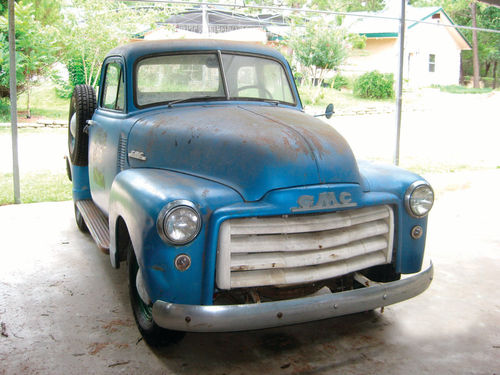

Uncle Lyle died in the ’50s and left the truck to Grandma, so it became a “farm truck.” Don, grandma’s son and my father-inlaw, used it for some years while attending college at Cal-Poly in the early ’60s.
My wife (then a little girl) remembers riding in the truck with her dad, driving out over the dry lake bed, chasing coyotes. His first job after college was in Hawaii, and he couldn’t afford (and the company wouldn’t pay) to send the truck over to Hawaii, so it went back to the ranch.
By this time Uncle Alvin, Don’s brother, was running the ranch. The truck became just another one the of many farm trucks on hand there. Occasionally they would use it to deliver eggs (they had some 9000 chickens) throughout several counties. Most of the time it was just used for hauling or runnin’ into town.
In the early ’80s Alvin’s son, Jimmy, was learning to drive. He was “assigned” the ’52 GMC. They painted it (again), rebuilt the engine (for the first time) and Jimmy ran it for several years. Once he graduated and got some money together, he bought something else (probably a newer GMC) and the truck was returned to “farm duty.” That was 1983. We know that one specific year, because that’s the last year the truck was registered. It still has the ’83 label on the rear license plate.
With that, the truck stayed on the farm and for at least the last 10 years it was stored in a barn with junk in the bed. Eventually it became covered with an inch of dust.
A Dusty Gift
Recently, Uncle Alvin had been getting tired of farming (at about 80) and we discussed what to do with some of the equipment. Since I’ve been known as an “old car guy” for a while Alvin asked me how he might go about selling some of the farm’s old trucks and how to price them. We talked about using Internet sites and finding local car clubs, etc.
I then mentioned to him that “I don’t know what the ’52 is worth but when you find out, let me know. If I can afford it, I’d like to have it,” (mostly for the family connection).
That following Christmas Uncle Alvin called up and said “Merry Christmas!
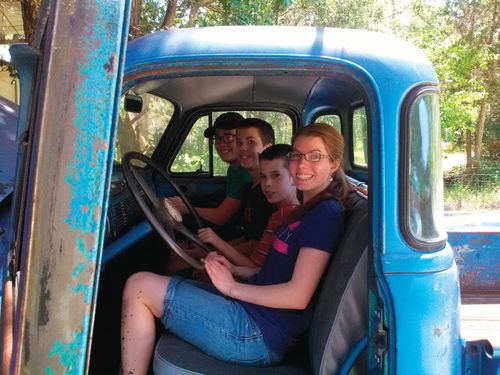
“Where do you want me to send the ‘pink slip’?” (California titles were pink at the time; not sure if they still are). Needless to say my wife and I were ecstatic. We made arrangements to pick up the truck on our next trip out west for the fall hunting season.
After a little planning with friends in Arizona with a car hauling trailer we were set. With no travel trailer, we built a bed for the back of the ’06 Dodge, and off we went.
We hauled the ’52 back to Texas by way of some scenic places on the California coast and then the Grand Canyon. Everyone that saw it advised how we should “restore” it, how to make it pristine or how they would modify it. Only a few times I explained that we were going to make it safe, get it running and drive it. No restoration. Besides, it’s not an “old” truck.
First a Bath and Then Recruit Some Young Help
The truck got several baths before we started working on it. Between rats living in the seat, several inches of good clean farm dirt in every nook and cranny, and a healthy layer of grease and grime underneath, it needed it.
Also, it’s fun to discover all the “stuff” that finds its way into well-used vehicles. Between the number of 32 Winchester Special brass and 12-gauge empty shells (remember chasing after coyotes?), farm parts, unusual rocks and arrowheads, bolts and some things we never did identify, we found this part of the project to be truly amazing.
So by early winter 2015 we were ready to start working on it. I mentioned to a friend at church who homeschools his children that we got the truck and asked if he knew any homeschool kids that wanted to learn “auto shop.” It seemed a shame to do all the work on this project and not have someone in the next generation learn from it. A few days later he called and said “I’ll have four kids over there on Thursday morning!”
A List of Accomplishments

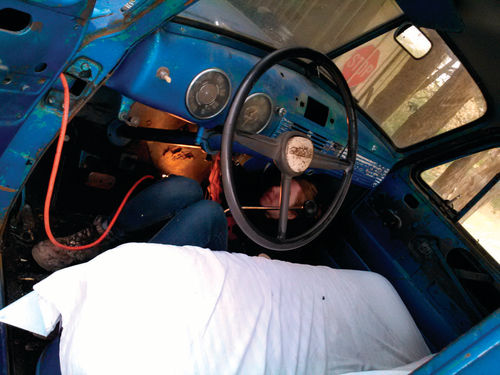
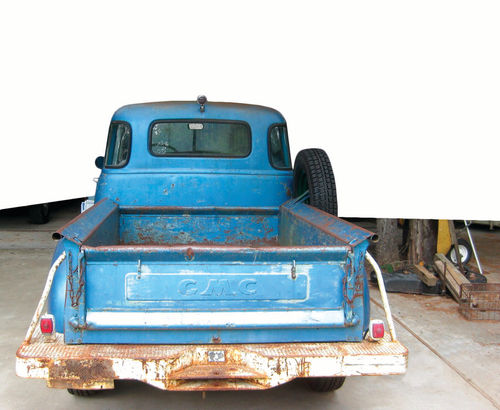
All through 2016 this was our routine: I’d order parts, plan the work and do things I wasn’t ready to teach the kids to do (machining special tooling, mainly) and every Thursday morning the kids would come over ready to “work on the truck.”
The kids, all siblings, included a young lady of 16 and her brothers who were 14, 12 and 10. They weren’t highly versed in the use of hand tools nor on how cars work. They now know the various types of screwdrivers, wrenches and other tools and how to use them properly.
You can see from the following list of things we’ve done that they’ve been acquainted with numerous areas of how a car is built, from upholstery to suspension to electrics. We’ve even fixed their family cars and lawn equipment on several occasions. They are all smart, learn fast, good workers, polite and never fuss when I ask them to get on the creeper and scrape the gunk off the nether reaches of the truck. More than a few times they’ve proudly gone home with greasestained hands.
Some of the things we did in 2016 were:
• Rebuild the driver door—new glass, glass channels, rubber seals, lube the window crank, rebuild the latch and lock.
• New spring shackles, pins, pivots, etc. including new frame bushings and all zerks. We welded a broken leaf in one leaf pack. Note: It had been broken for at least 40 years and might have continued to work, but I thought it would be best to fix it and fun for the kids to see how to weld and temper a spring.
• Replace all brake shoes (some weren’t too bad but since I had them we replaced them), packed front wheel bearings (the old school way with a blob of grease in the palm of your hand), adjusted and bled the brakes.
• Lights—rebuild the front driving (bullet) lights (these units are not cost effectively available any more. I decided to rebuild the assembly which required making some tooling to stake studs in the housings and rebuild the wiring connections); re-build and rewire rear lights, (again rebuilding the wiring connections) adjust the headlights, rebuild the dome light and rear bed spotlight. Interior work, including:
• Complete reupholstering of the seat—this included removal of about four generations of blankets, covers, tarps and other “seat covers”; eviction and demolition of countless mousehouses in the spring packs (those were particularly “aromatic” in the summer) re-wiring the spring packs and finally installing a somewhat illfitting aftermarket upholstery set.
• Replacing the headliner (again, eau de mouse accentuated); patterning and cutting a replacement floor mat.
• Removal of the unknown vintage, unoriginal AM tube radio. Exterior work, including:
• Cowl vent seal replacement— which showed us that the original color of the truck was a “sea green.” We used this to try to buy paint for the wheels but alas, no formula exists for that color. We opted for another (supposed) ’52 GMC green factory color. I’m not sure how authentic it is.
• Replace rear center window.
• Polished scratches off quarter windows. Engine work, including:
• Drain oil and clean the oil filter housing.
• Rebuild the carburetor.
• Start work on a replacement air filter—more on this in another installment of this story.
• Clean the crud off the transmission, lower part of engine and areas around the springs. Dang! We really got a lot done this last year.
Paying Attention to the Wheels
Here’s a little side story on the rims: When I had my 1937 Plymouth Coupe (bought in 1974, sold in 2006) I found that the pattern of the wheels was “unique” to that year or to a narrow set of years. Very few people paid any attention to this, but it sensitized me to the “vintage” factors of rims.
Our truck had three different types of rims on it when I got it. The rears had snow tires on them, probably borrowed from whatever vehicle had the tires on it and didn’t need them at the time. All, of course, were “six-lug Chevy pattern” but one was 5¼” wide, while the others were 5½” wide. Some had eight “spokes” (holes in center part of rim), others had four spokes. This told me two things:
1. I should find out what is the correct version.
2. If I wanted them to match, I’d need a few more rims. To that end, this last year’s trip (Oct. 2016) back to the “family farm” allowed me to pick up several more rims that Alvin had laying around. He has hundreds of various rims and tires, even including some old Maxwell rims on a water cart. I now had a full set of five of the correct four-spoke, 5 1/2”-wide rims.
Prepping for Preferred Tires
Now, having worked for Michelin in a past life, I readily admit a bias (tire pun intended) toward their products. I want to put Michelins on this truck even though I KNOW they aren’t original. But, hey, if I get 95,000 miles out of them, as I’ve done on two other trucks, I don’t care. I want Michelins.
That said, putting any tubeless tire on those somewhat rusty, slightly pitted rims is an opportunity for leaky tringles (beads). With that in mind, I had all five of the correct rims sandblasted. I then acid etched them with phosphoric acid to make an iron phosphate crystal bonded coating and sprayed them with an epoxy primer and then the green paint (incorrect for this vehicle but supposedly correct for a ’52 GMC truck). It’s more like a John Deere green than the original Sea Mist. But that will be OK. As I said earlier, the family always liked John Deere too.
A Handy Device for Painting Rims
Painting rims has always been a problem for me—especially when they are on the vehicle. Due to the angles and curves, I always had some minor “shadows”—areas that didn’t get perfect paint coverage. Having pondered this problem on and off for some 45 years and having tried such things as mama’s Lazy Susan off the kitchen table (caught it for that!); I finally built a cylindrical fixture to hold them steady. It’s simple, cheap, effective, and made with some “stuff” from around the shop.
Handling the wet rims took a bit of finesse but the fixture worked as needed. If I were going to do another batch, I might make a “gang” fixture with five spindles to reduce handling the rims while wet.
An Appropriate Farm Logo
As stated before, one objective I had with this project was to keep the truck mostly original, in all its “farm glory.” Other than a few functional improvements, I’m not planning on a restoration. I want it to run well, be safe but to look like an old truck. I don’t need cosmetic surgery, so why should a “young” truck need it? The one variance from the original theme is to add what Uncle Alvin should have done long ago—put a logo on the door.
To me, a farm truck looks its best if it has the farm brand or logo on it. And besides, that’s part of the story of this truck. It’s a farm truck that spent almost all of its life on the family farm.
Unfortunately, the stencils, original truck paint and stencil paint (POR15) didn’t play too well together. We had some runs, bleeding and some heavy peel off the original paint on the passenger door. But in the end, it turned out “right” for a farm truck.
Keeping Things Honest
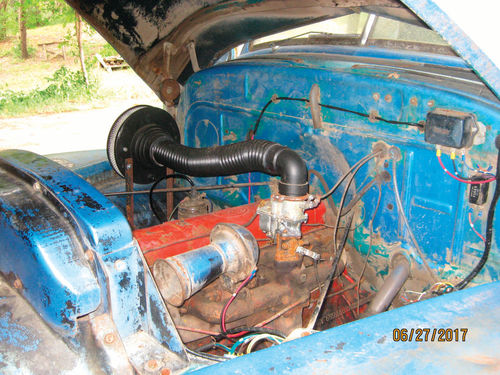
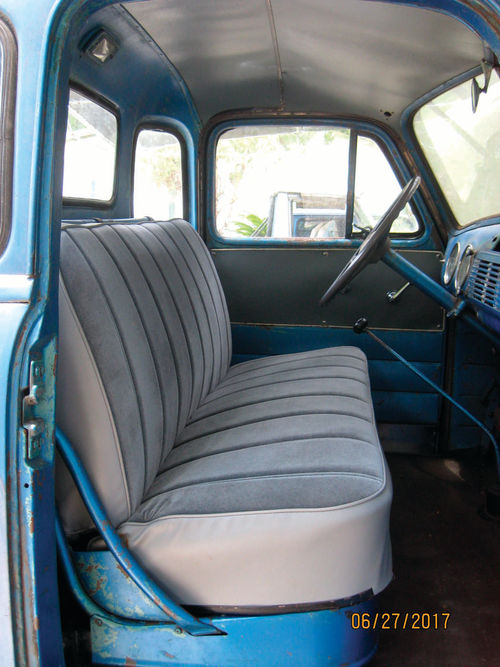
For the past decade or so, my parttime job has been repairing guns. One of the guys in a gun shop I do work for uses the term “honest gun.” This term is used to describe a gun that is “correct.” It has all the original components and hasn’t been modified or restored. It’s just a well-used, fairly well-cared-for gun. It’s not trying to be something it’s not. Thus, it’s an “honest gun.”
While I want this truck to be (mostly) an honest truck—I am accepting some changes. While the freshly painted rims will definitely stand out as “restored,” the faults of the logo will certainly look reasonable for what this truck is…a farm truck. Eventually we will put some kind of radio in it. Not an expensive “retro” radio, just something to play ’50s music when I’m driving. Maybe it will be an under-dash unit.
We’re Now a Crew
We recently had team t-shirts made for the kids to commend them for their work. They are now known as the ’52 Pit Crew and have the shirts to prove it.
We figure that they’ll have quite a story to tell their friends when they’re asked, “What’s the ’52 Pit Crew?”















